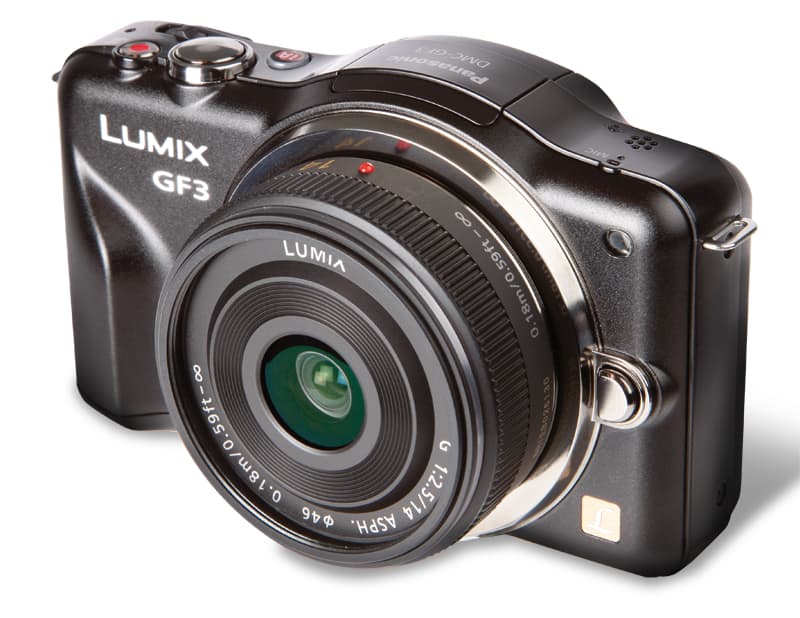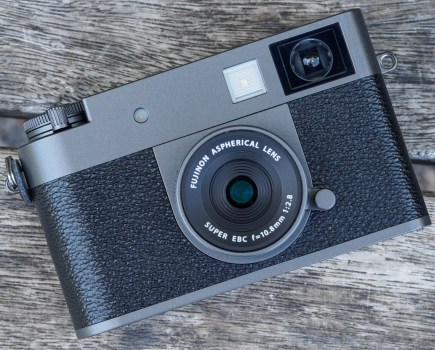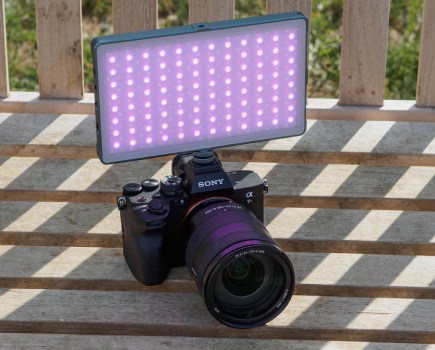Panasonic Lumix DMC-GF3 at a glance:
- 12.1-million-pixel MOS sensor
- 1080i HD video
- ‘Light-speed’ AF at 0.1secs
- 107.5×67.1x32mm body
- £499 with 14-42mm lens
- £549 with 14mm lens
- £629 with 14-42mm and 14mm lenses
Panasonic is clearly committed to the development of its micro four thirds, compact system camera (CSC) series. The frequency with which new camera bodies and lenses are introduced is testament to this, with the GF3 appearing less than a year after the GF2. This latest incarnation is the company’s ninth CSC model, the first being the Lumix DMC-G1 in October 2008.
The company’s G-series CSCs are split into three camps: the DSLR-style ‘G’, compact-style ‘GF’ and the video-focused ‘GH’ models. For now, the system is strong in number and shows no sign of slowing down.
Along with the release of the GF3, the company announced a 25mm (50mm equivalent) f/1.4 Asph lens, which is a useful focal length. For current owners, being part of a system that is actively being developed and invested in is great news, and a key pull factor: as a consequence of this expansion, the lens range is beyond that of any other CSC. Furthermore, the GF3 is also compatible with Olympus four thirds optics.
Compact system cameras are great at offering the controls and features one would expect from a DSLR but in a smaller body. As a well-established system, what is of particular interest here is how Panasonic is developing the compact-style GF series. Each time a new model is announced, it sheds a few grams and millimetres, which means the GF3 is the smallest and lightest GF model to date.
Given its moniker, it would be logical to assume that the GF3 is a replacement for the GF2.
However, Panasonic informs us that this is not the case, and for now the GF2 will continue to be available. Also, the initial RRP of the new model is lower than when the GF2 first hit the shelves, so the GF3 sits at the bottom of the range. It would appear, then, that Panasonic’s primary concern with the GF3 is to achieve wider consumer appeal by providing a cheaper and smaller CSC. The major point for consideration, therefore, is whether it is as effective as its predecessors and just where, if any, compromises have been made.
Features
In its attempt to hold the title of the world’s smallest interchangeable-lens camera with built-in flash, the Panasonic Lumix DMC-GF3 is 17% smaller and 15% lighter than its predecessor, the GF2. Although Pentax has since released details of its Q-mount CSC, which is both smaller and lighter than the GF3, it makes use of a 1/2.3in sensor – the type found in compact cameras – so they are not truly comparable. The world’s smallest interchangeable-lens camera with four thirds sensor and built-in flash, therefore, is indeed the GF3!
Any camera carrying the Panasonic Lumix G four thirds mount will benefit directly from 12 lenses, including a wide zoom, three standard zooms, two telephoto zooms, three primes, one macro, one 3D optic and the new 25mm f/1.4 Asph. This last one is a lens that we have been waiting to see, and I am excited about using it.
One general gripe about CSCs is that their lenses are disproportionately bulky compared to the bodies. Because of the smaller sized sensor and flange depth (the distance between the lens ring and the sensor) of the GF3, lenses can in theory be manufactured smaller and lighter than those for APS-C-format cameras, such as with the Sony NEX and Samsung NX series.
Like for like, the Panasonic Lumix G four-thirds-mount lenses complement the compact-style body a little better than direct competitors, albeit marginally. The compact size works especially well when paired with a pancake lens, such as the 14mm kit lens, to make a camera that is comfortably pocketable and a great option for discreet street photography.
Like the GF2 before it, the GF3 uses a 12.1-million-effective-pixel MOS sensor. Images can be recorded in Panasonic’s RW2 raw format and JPEG, with a range of aspect ratios available at the touch of a button.
The four thirds sensor has a maximum file size in 4:3 format of 4000×3000 pixels, but the 3:2 format used as standard by APS-C-sized sensors is available at 4000×2672 pixels. The 1:1 format is a useful tool with which to develop an eye for square-frame photography. Many internal aspects remain the same.
The GF3 makes use of the Venus Engine FHD processor, which provides speedy operation of the AF system, and noise control across the ISO 100-6400 sensitivity range. In this case, however, there is an improved frame rate of 4fps.
Thanks to the last generation of Panasonic cameras, we now have high expectations of the company’s AF system in its micro four thirds range. The firm claims the GF3 can focus from 2m to infinity in 0.18secs when used with the 14-140mm lens and loaded with firmware version 1.3 or later. Like the GF2, the GF3 has single, continuous and manual (with the option to enlarge the focus area) focus modes, and AF modes include 23-point, single point, tracking AF, face-detection AF and pin-point AF (which makes use of the 3in touchscreen).
Video users are likely to be happy with what the GF3 has to offer. It shoots at up to full HD (1080p) resolution, and all the camera’s effect and colour modes are available, which is great for creative shooting.
iA+ is a second intelligent auto mode that operates in a similar way to iA, but incorporates a slider on the touchscreen to adjust aperture, colour or brightness via an on-screen illustration rather than using jargon.
Another new aspect to the interface is the GUI menu screen, which provides access to the shooting modes. Found under Creative Control, these include mini effect, high key, retro, sepia, high dynamic and expressive. It seems that several of the new handling features demonstrate that the GF3 is geared to the more entry-level user.
Build and handling
The external dimensions of the GF3 measure 107.5×67.1x32mm, excluding protrusions. When used with the 14mm pancake lens, the size difference between this and Panasonic’s flagship compact camera, the Lumix DMC-LX5, is barely distinguishable. The GF3 is larger by the smallest of margins, which is no mean feat considering the GF3 holds a much larger sensor. Between the GF3 and the Sony NEX-C3, the NEX-C3 is slightly smaller.
It is clear that the main talking point of the GF3 is its tiny size. It is so small, in fact, that the circumference of a lens like the 14-140mm is larger than the height of the camera body. As such, the body curves elegantly around the mount to fit such a lens in, and therefore make the camera’s use with a tripod possible.
The body feels solid enough, housed in a tough and lightweight aluminium casing, with grooves for thumb and hand moulded to a natural holding shape. It rests beautifully in the hand, and it is only when larger lenses such as the 14-140mm optic are mounted that the other hand is needed for extra support.
 As well as the reduction in size and weight and the change of shape, there is a new control wheel. This complements the touchscreen very effectively, giving two options for navigating menus and shooting settings. The shooting mode can be selected via the new GUI menu. This is like having a shooting mode dial, but it is on the touchscreen instead of the top-plate, as with advanced camera bodies. Modes can be selected by touch or via the control wheel. Consequently, the GF3 is very quick to handle.
As well as the reduction in size and weight and the change of shape, there is a new control wheel. This complements the touchscreen very effectively, giving two options for navigating menus and shooting settings. The shooting mode can be selected via the new GUI menu. This is like having a shooting mode dial, but it is on the touchscreen instead of the top-plate, as with advanced camera bodies. Modes can be selected by touch or via the control wheel. Consequently, the GF3 is very quick to handle.
It comes as no surprise that certain sacrifices have been made. The most obvious is the omission of a hotshoe mount, meaning there is no option to use an external flashgun or viewfinder. It is a bold step for Panasonic, and a tricky one, as this may well be enough to put some people off the GF3 – especially those who desire creative off-camera flash or a viewfinder in bright conditions. A flash has not been sacrificed completely, though, as a pop-up unit is positioned centrally on the body above the lens, with a GN of 6m @ ISO 100.
White balance and colour
I am pleased with the punchy yet natural colours of images taken with the GF3. On a bright sunny day, the standard colour setting is almost a little too vivid, but the natural colour setting gives nicely understated results.
Colour modes are accessed via Photo Style in the main menu and can be tweaked ±2 for contrast, saturation, sharpness and noise reduction. Tweaking the saturation in monochrome gives a pleasant sepia or cyanotype result. One favoured adjustment in Photo Style can be saved as a custom setting for quick access. I am happy to see that all the colour settings are also available in video mode.
White balance control offers five presets and two custom, plus auto and Kelvin settings. The latter is easily adjusted between 2,500K and 10,000K using a slider on the touchscreen or the control wheel. This comprehensive control also allows further adjustment on the blue/amber and magenta/green axis.
There are no surprises about how the white balance performs. Auto white balance can be relied upon in most settings, but renders a warmer tone in tungsten light, which is not unusual.

Image: In tungsten light the auto WB can be very warm, so images benefit from the tungsten WB setting.
Metering
Like most cameras, the AF and metering systems are linked in certain aspects. The evaluative metering uses a 144-zone area. I found that it leans towards metering correctly for the midtones. Within the constraints of a slightly limited dynamic range, this often results in bright highlights blowing out, but exposure compensation is available via the press and turn of the control wheel.
The nicest thing about the metering system is using spot metering. The single point can be shifted intuitively by using the touchscreen to anywhere but the very edges of the frame. Press the precise area of the screen, or even use the control wheel, and the camera adjusts. The size of this area can be adjusted to take in a smaller or larger area. I found this type of metering particularly useful for scenes of high-contrast light, making sure that small areas of bright highlights are not blown out.
Noise, resolution and sensitivity

Back in January this year, we thought that the GF2 felt a little dated with its 12.1-million-pixel imaging sensor. So it is disappointing, to find that the GF3 has kept the same sensor as the GF2.
However, the GF3 is not a direct replacement and, in this respect, what is on offer for the size and price of the body is respectable. I expect improvements to the imaging sensor for the GF2’s direct replacement, most likely in the form of the 16.2-million-pixel sensor found in the DMC-G3.
A 4000×3000-pixel output equates to a 13x10in-sized print without any degradation in image quality, so if you want to print much bigger, a larger sensor is more appropriate.
According to our resolution charts, the GF3 is capable of resolving detail up to 26 in raw format at ISO 160, and up to 24 in JPEG files. This is respectable, and matches the direct competition despite the smaller sensor. At ISO 6400, resolution detail drops to around the 20 mark, which shows that while noisy, there is still a good level of detail at the highest settings.
Smaller sensors often suffer from high levels of noise as the photosites are less able to collect light, especially at high sensitivities in low-contrast light. The GF3 offers a wide sensitivity range of ISO 160-6400, but images are particularly noisy at the top end of the range. While the GF3 is still a strong performer, this is perhaps the most significant area where it is found wanting.
Image: Using a prime lens such as the 14mm here, the Panasonic Lumix DMC-GF3 gives sharp results with plenty of resolved detail.
Panasonic Lumix DMC-GF3 – Resolution

Resolution, noise & dynamic range: These images show 72ppi (100% on a computer screen) sections of images of a resolution chart, captured using the Panasonic 14mm f/2.5 lens set to f/8. We show the section of the resolution chart where the camera starts to fail to reproduce the lines separately. The higher the number visible in these images, the better the camera’s detail resolution is at the specified sensitivity setting.
Autofocus
 Like the GF2 before it, the GF3 is particularly impressive with regard to autofocusing.
Like the GF2 before it, the GF3 is particularly impressive with regard to autofocusing.
As with the metering, single-point AF can be defined by touch, so it’s a breeze to use and very responsive. On a similar basis, and for even more precise focusing, there is the pin-point AF mode.
It operates in much the same way as single-point AF, although in the latter, the focus area can be adjusted by the control wheel or by touch, and the size of the area changed.
With pin-point AF, the desired focus area is assisted by viewing magnification (as in manual focus) and the photo is taken using the shutter on the touchscreen.
In good light, 23-point AF is virtually instant, and almost as quick in low-contrast light. The exact timing does depend on the lens and body combination and the level of available light, but for a camera at this level I am very impressed.
Image: Pin-point AF makes use of the touchscreen and covers the majority of the frame, enabling a quick and precise shift in focus
I found the AF to be reliable and manual focus to be a useful back-up.
I have generally been disappointed with tracking AF mode because all too often a camera cannot keep up with a moving subject, particularly in crowded scenes. In this respect, the GF3 is actually rather good, and a viable option for high-speed action. Continuous contrast detection AF is smooth and precise.
The final AF option is face recognition. There is the option to store several faces, and the AF areas are indicated on the screen around the subjects. This is a useful feature for those who regularly shoot portraiture.
LCD, viewfinder and video
There is no viewfinder and neither is there an option for one, which pushes the GF3 further towards the compact camera market. There is, however, a very effective touchscreen instead. Combine it with the control wheel, and navigating through all the menus and shooting modes is surprisingly quick, especially once you are familiar with the system.
In most lighting situations the touchscreen’s bright and crisp display means that information is clearly visible. In bright sunshine, however, it is a different story and it can be difficult make out what’s on screen. An ideal solution would have been to articulate the screen so it can be angled away from strong light, but this would push up the cost of the camera.
There is plenty on the GF3 to please video users. Full 1080p HD videos are backed up by a superb AF system and a host of lenses that feature Mega OIS for steady shots. There is no in-camera stabilisation, however. Continuous AF gives smooth focusing with minimal noise.
There is the option for AVCHD and MPEG movie files, which covers all bases from those who watch videos on the computer to those who watch on their HD television sets. MPEG files are up to 720p at 30fps, while the better quality AVCHD format can record up to 1080i at 50fps. Clip length is limited to 11mins 40secs in full resolution, and I found the camera does get a little hot towards the end of recording. Handily, all the photo style colour settings and creative effects are available in video mode as well as for stills, so both video and photo users should be equally pleased.
Unlike the GF2, the GF3 only records audio in mono, and there is no option for an external microphone. If audio is of key importance to your videos, then the GH2 is a better option.
Image: Using the touchscreen for spot metering is an effective way to ensure the correct exposure for highlights. it is achieved simply by pressing the relevant area of the frame

Dynamic range

Most of the changes between the GF1, GF2 and now the GF3 have been functional, rather than to imaging sensor. As such, there is little change to how the GF3 performs when it comes to the dynamic range.
At the time of writing, the official information was not available, but from viewing my images and knowing that the GF2 has a dynamic range of 10.3EV (www.dxomark.com), here the GF3 falls a little short. Even on a bright sunny day where the landscape is exposed to strong sunlight, the detail in the white of clouds is often washed out.
There is an option to autobracket, which can go some way to helping in high-contrast scenes. However, this is worked on a consecutive exposure basis, and with no option for a self-timer mode to keep the camera steady.
What’s more, the autobracket is not user defined. There is a choice of four settings, two at 1⁄3EV increments and two at 2⁄3EV increments, over three or five exposures. Because there is a gap between exposures, any movement such as fast moving clouds will mean exposure blending is difficult.
Finally, shading comp is designed to combat the effect of vignetting, and brightens the frame edge detail.
25mm f/1.4 lens
Coinciding with the release of the Lumix DMC-GF3, Panasonic has announced its long-awaited 25mm f/1.4 lens. Four thirds lenses have a 2x multiplication factor, which in this case translates as a 50mm optic. The four thirds format gives less control over shallow depth of field than larger formats, so using a lens that can open up to f/1.4 goes some way to remedying this. It is a  Leica-certified optic comprising nine elements in seven groups, with two aspherical lenses.
Leica-certified optic comprising nine elements in seven groups, with two aspherical lenses.
At 200g, the 25mm f/1.4 is reassuringly weighty and well constructed, without throwing the balance of Panasonic’s lightest and smallest micro four thirds camera. The lens is relatively compact, too, at 54.5mm long. When paired with the GF3, you have a genuinely good option for sharp portraits from the most lightweight of set-ups.
Given that the GF3 is found wanting a little in low-contrast light, this type of lens counters it well. Like many other lenses in the range, however, it is expensive and, at £548.99, costs more than the GF3 with kit lens.
Competition


Olympus’s E-PM1 is the company’s smallest micro four thirds camera to date, aiming for the same buyers as the Panasonic Lumix DMC-GF3. We have not tested the E-PM1, but the specification suggests there is little to choose between it and the GF3. However, the E-PM1 does feature a hotshoe.
The Pentax Q system may be the smallest interchangeable-lens camera system, but its significantly smaller imaging sensor means that the system has more in common with a compact camera and will probably fall short of the GF3.
Sony has recently released the replacement for its smallest CSC camera in the form of the NEX-C3. It has a larger APS-C imaging sensor than the GF3 and a hotshoe port to mount an external viewfinder or flash, but instead of a built-in flash an external flash is included. We find its handling a little tricky, especially for those wanting to use manual controls.
Verdict
The more I used the Panasonic Lumix DMC-GF3, the more it became apparent that this model is a clear move to tap into the entry-level market. However, other users should not let that put them off.
The combination of touchscreen and on-camera buttons, such as the control wheel, provides excellent and intuitive handling. Combine this with a superb AF system, and the GF3 is a pleasure to use. It is backed up by an increasingly strong selection of lenses, too.
The small body puts the GF3 on the verge of compact camera status, and has led to the sacrifice of a hotshoe port. Users are therefore reliant on the limited-output built-in flash for any flash photography, and the touchscreen for viewing and composing images. Bright sunlight can be a little problematic for image composition and viewing.
Where the GF3 falls a little short is through its imaging sensor, which has remained unchanged since the first-generation GF model. This now makes it a little dated when compared to its competition. This latest offering, however, is a much cheaper and smaller version. I would expect the true replacement for the GF2 to develop the imaging core, most likely through the 16.2 million pixel sensor found in the G3.
I enjoyed testing the Panasonic Lumix DMC-GF3. It offers a compact and affordable entry point to what is an increasingly strong system.
Panasonic Lumix DMC-GF3 – Key Features
Built-in flash
There is no hotshoe adapter. Instead, the Panasonic Lumix DMC-GF3 has a built-in flash with a GN of 6m @ ISO 100
Touchscreen
Viewing and composing images is achieved solely through the 460,000-dot touchscreen
Creative control
Creative control effects such as HDR (high dynamic range), high key, sepia, miniature effect and retro can be applied to both still and moving images.
Intelligent auto
Like previous models, the GF3 offers intelligent auto (iA), but this time there is also iA+. Both modes assess the scene and select the most appropriate shooting setting, but iA+ uses a slider on the touchscreen for adjustments, with on-screen diagrams rather than jargon to aid the user.
Photo style
In the photo style menu, there are different colour settings such as natural, vivid and monochrome. Each setting can be tweaked ±2 for saturation, contrast, sharpness and noise reduction.
Built-in flash
The GF3 is the interchangeable-lens-system camera with a built-in flash. Its output of GN 6m @ ISO 100 is a little limited, but still good for close-range portraits.
Control wheel
The control wheel is new to the Lumix G-series range, taking the place of the D-Pad. The wheel works very effectively with the touchscreen for quick handling and menu navigation.
Curved body
Because the GF3 is 17% smaller than the GF2, it requires an elegant curved design in order to effectively hold some of the bulkier lenses in the Lumix range.









